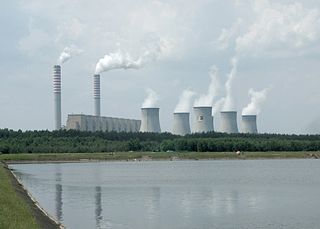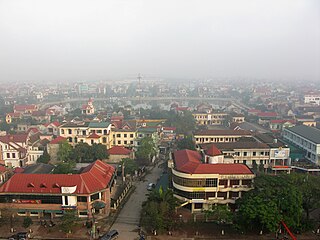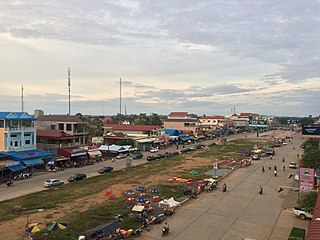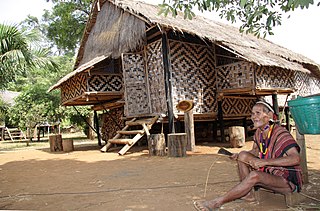Related Research Articles

The politics of the Lao People's Democratic Republic takes place in the framework of a one-party socialist republic. The only legal political party is the Lao People's Revolutionary Party (LPRP). The head of state is President Thongloun Sisoulith, who is also the LPRP general secretary, making him the supreme leader of Laos. The head of government is Prime Minister Phankham Viphavanh.

Kaysone Phomvihane was the first leader of the Communist Lao People's Revolutionary Party from 1955 until his death in 1992. After the Communists seized power in the wake of the Laotian Civil War, he was the de facto leader of Laos from 1975 until his death. He served as the first Prime Minister of the Lao People's Democratic Republic from 1975 to 1991 and then as the second President from 1991 to 1992.

India is the third largest producer of electricity in the world. The national electric grid in India has an installed capacity of 393.389 GW as of 31 December 2021. Renewable power plants, which also include large hydroelectric plants, constitute 37% of India's total installed capacity. During the fiscal year (FY) 2019-20, the gross electricity generated by utilities in India was 1,383.5 TWh and the total electricity generation in the country was 1,598 TWh. The gross electricity consumption in FY2019 was 1,208 kWh per capita. In FY2015, electric energy consumption in agriculture was recorded as being the highest (17.89%) worldwide. The per capita electricity consumption is low compared to most other countries despite India having a low electricity tariff.

Kon Tum province lies in the Central Highlands region of Vietnam and shares borders with Laos and Cambodia. It has an area of 9,934 square km and a population of approximately 530,000. The economy is primarily agricultural.

A fossil fuel power station is a thermal power station which burns a fossil fuel, such as coal or natural gas, to produce electricity. Fossil fuel power stations have machinery to convert the heat energy of combustion into mechanical energy, which then operates an electrical generator. The prime mover may be a steam turbine, a gas turbine or, in small plants, a reciprocating gas engine. All plants use the energy extracted from expanding gas, either steam or combustion gases. Although different energy conversion methods exist, all thermal power station conversion methods have efficiency limited by the Carnot efficiency and therefore produce waste heat.

Jindal Steel and Power Limited (JSPL) is an Indian steel and energy company based in New Delhi, India. With turnover of approx. ₹40000 crore, JSPL is a part of about ₹130000 crore diversified O.P. Jindal Group conglomerate. JSPL is a leading player in steel, power, mining, oil and gas and infrastructure in India. The company produces steel and power through backward integration from its own captive coal and iron-ore mines.

Hà Tĩnh is a province on the North Central Coast of Vietnam. Together with neighbouring Nghệ An province the two provinces are together called "Nghệ Tĩnh", and the locals are known for speaking Vietnamese with a very noticeable regional accent.

Stung Treng City is the capital of Stung Treng Province, Cambodia. It is the major city of both the district and province.

China is the largest producer and consumer of coal in the world and is the largest user of coal-generated electricity, with over a thousand coal-fired power stations. The share of coal in the energy mix declined during the 2010s, falling from 80% in 2010 to 58% in 2019, but still emits over 10% of global greenhouse gas. China's large demand was in part responsible for the delay in peak global coal production, and coal consumption in China is forecast to reach a record high in 2021.
Kaleum is a district (muang) of Sekong province in southeastern Laos. In 2013, more than 100 families who inhabited the district were displaced by the construction of the Sekong 4 Dam.
Coal reserves in Canada rank 13th largest in the world at approximately 10 billion tons, 0.6% of the world total. This represents more energy than all of the oil and gas in the country combined. The coal industry generates CDN$5 billion annually. Most of Canada's coal mining occurs in the West of the country. British Columbia operates 9 coal mines, Alberta nine, Saskatchewan three and New Brunswick one. Nova Scotia operates several small-scale mines, Westray having closed following the 1992 disaster there.

Coal phase-out means stopping burning coal, and is part of fossil fuel phase-out. Coal is the most carbon-intensive fossil fuel, therefore phasing it out is critical to limiting climate change and keeping global warming to 1.5 °C as laid out in the Paris Climate Agreement. The International Energy Agency (IEA) estimates that coal is responsible for over 30% of the global average temperature increase above pre-industrial levels.

The Katu people are an ethnic group of about 102,551 who live in eastern Laos and central Vietnam. Numbered among the Katuic peoples, they speak a Mon-Khmer language.
This page describes energy and electricity production, consumption and import in Laos.

Attapeu is a province of Laos in the southeast of the country. It has five districts: Samakkixay, Xaysetha, Sanamxay, Sanxay, and Phouvong, covering an area of 10,320 square kilometres (3,980 sq mi) with a population of 127,285. Its capital city lies at Attapeu.

Sekong is a province of Laos in the southeast of the country.

Hongsa is a town in northwestern Laos. It is in Hongsa District in Sainyabuli Province. The town is 81 kilometres (50 mi) northwest of the provincial capital Sainyabuli. Nearby Ban Viengkeo is a rotating host to a major elephant festival. The district is the site of the Hongsa coal-fired power plant that began operation in 2015.

Coal supplies over a quarter of Turkey's primary energy. The heavily subsidised coal industry generates over a third of the country's electricity and emits a third of Turkey's greenhouse gases.
Hongsa is a district of Sainyabuli province, Laos. The main town in the district is Hongsa town, where a coal-fired power plant is located.
References
- ↑ "Districts of Laos". Statoids.
- ↑ Laos Ministry of Education district maps Archived 2017-02-11 at the Wayback Machine (archive)
- ↑ Phonevilay, Latsamy (5 February 2021). "Laos to Build Two Coal-Fired Plants in Xekong Province". The Laotian Times. Retrieved 5 February 2021.